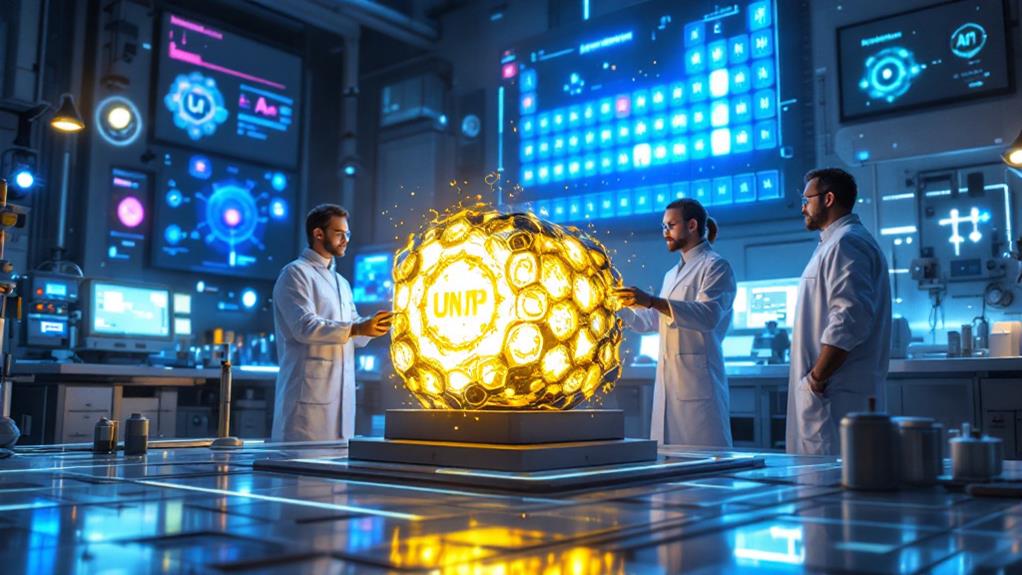What Is Ununpentium? Discovering Element 115

You're about to reveal the fascinating story of moscovium, originally called ununpentium, a synthetic element with the atomic number 115. Identified in 2003 by Russian and American scientists, moscovium was made by bombarding americium-243 with calcium-48 ions. It's part of the superheavy elements and has fleeting half-lives, complicating its study. Its predicted metallic characteristics resemble bismuth, with potential uses in energy and medical fields, although applications remain theoretical due to its instability. The synthesis of moscovium expands our understanding of both nuclear physics and the periodic table as science investigates further possibilities.
The Discovery of Element 115
In the world of chemistry, the identification of element 115, known as ununpentium, was a significant milestone. You might find it fascinating that this element's revelation marked a leap in our understanding of the periodic table's outer reaches. The elemental history of ununpentium starts in 2003 when a team of Russian and American scientists at the Joint Institute for Nuclear Research in Dubna successfully created it. They bombarded americium-243 with calcium-48 ions, resulting in a few fleeting atoms of ununpentium, although it was highly unstable and decayed rapidly.
As you explore the naming origins, you'll find that the temporary name "ununpentium" comes from the Latin and Greek roots meaning "one-one-five," reflecting its atomic number 115. This placeholder name followed the convention used for elements yet to be officially named. In 2016, the International Union of Pure and Applied Chemistry (IUPAC) officially acknowledged the element and assigned it the name "moscovium" in honor of the Moscow region, recognizing the collaborative effort of the scientists involved. Understanding the revelation of element 115 gives you insight into the complexities and achievements in modern-day chemistry endeavors.
Understanding Moscovium's Properties
Having investigated the origins and uncovering of element 115, it's time to scrutinize the intriguing properties of moscovium. To begin with, moscovium is a superheavy element with an atomic number of 115. It's a member of the p-block in the periodic table and falls under the category of post-transition metals. When you probe into its chemical behavior, you'll find that moscovium exhibits properties typical of heavy elements. It tends to form compounds with oxidation states, likely mirroring those of its lighter congeners.
However, understanding moscovium's isotopic stability is essential because it directly affects how the element behaves. Moscovium has no stable isotopes, which means it exists only in highly radioactive forms. The most commonly studied isotope, ^289Mc, has a half-life of approximately 220 milliseconds. This fleeting existence makes it challenging to study its properties extensively in laboratory conditions.
Despite these challenges, researchers have gathered valuable insights into moscovium's decay patterns and the nature of its isotopes. By analyzing its decay chains, scientists can predict potential chemical reactions and interactions with other elements. As you investigate further, these foundational properties of moscovium will shape your understanding of its place in the chemical world.
Synthesis Process and Challenges

Synthesizing moscovium presents a formidable challenge due to its superheavy nature and rapid decay. As you explore its synthesis process, you realize why it's no small feat. The production methods involve bombarding lighter elements with ions, aiming for fusion. However, achieving isotope stability is a significant hurdle. Moscovium's isotopes decay swiftly, making their detection and analysis tricky. You need to create the conditions for a fleeting existence, and that requires accuracy and perseverance.
To get a better grasp of the synthesis process, consider the following steps:
- Target Element Selection: Choose a target element such as americium, which can be bombarded with ions. This selection is essential since it sets the stage for potential fusion.
- Ion Bombardment: Accelerate calcium ions to high speeds using a particle accelerator, then direct them toward the target. This phase demands careful control over speed and direction.
- Detection and Analysis: Employ sophisticated detectors to capture the brief existence of moscovium isotopes. This step is where the challenge of isotope stability becomes most apparent.
Significance in Modern Science
Although synthesizing moscovium is a complex task, its importance in modern science can't be overstated. Moscovium, also known as Element 115, sits at the forefront of our understanding of superheavy elements. In a historical context, its identification marked a milestone in the periodic table's expansion, highlighting the collaborative efforts of scientists across the globe. You might wonder why this matters; well, each new element broadens our scientific horizons and challenges existing theories.
The scientific implications of moscovium are profound. It helps scientists investigate the "island of stability," a theoretical range of superheavy elements that might possess longer half-lives and unique properties. By studying moscovium, you're not just looking at a new element; you're peering into the possibilities of advanced nuclear physics. Moscovium's behavior provides clues about the forces holding atomic nuclei together, which could redefine models of atomic structure.
Furthermore, moscovium's short-lived nature offers a unique glimpse into the life cycle of superheavy elements, enriching your understanding of matter itself. While its applications might seem distant now, the knowledge gained from studying moscovium is an essential stepping stone for future scientific breakthroughs, underscoring its undeniable significance in the scientific community.
Potential Applications Explored

Exploring the potential applications of moscovium opens up exciting prospects despite its fleeting existence. As a synthetic element with unique properties, it offers intriguing possibilities in multiple fields. Although its half-life is incredibly short, researchers are still keen on revealing its potential.
- Energy Production: Moscovium's potential role in energy production is fascinating. While it's not yet a practical source, theorists wonder if it could contribute to future energy systems. Its heavy atomic mass and unique properties might hold secrets that could revolutionize how we generate power.
- Medical Imaging: In the domain of medical imaging, moscovium could offer groundbreaking advancements. Scientists speculate that its decay properties might be harnessed to improve diagnostic techniques, providing clearer and more detailed images. This could lead to earlier detection of diseases, ultimately saving lives.
- Nuclear Research: Moscovium's behavior in nuclear reactions continues to pique interest. Understanding its interactions could lead to safer and more efficient nuclear technologies. While direct applications are still theoretical, studying moscovium might guide improvements in nuclear safety and waste management.
Future Research Directions
Scientists are enthusiastic to investigate deeper into the mysteries of moscovium, paving the way for groundbreaking revelations. As you examine its future research directions, you'll find that there's a domain of possibilities waiting to be uncovered. One major area of interest is understanding the theoretical implications of moscovium, particularly in nuclear physics. Researchers are keen to study its stability and decay patterns, which could offer insights into the limits of the periodic table and the forces that bind atomic nuclei.
Another exciting direction is the investigation of moscovium's cosmic origins. You might wonder how such heavy elements are formed in the universe. By analyzing moscovium's properties, scientists hope to gather clues about the processes happening in supernovae and neutron star collisions, where these elements are believed to originate. This knowledge could deepen our understanding of the universe's evolution and elemental composition.
In your expedition through moscovium research, you'll likely encounter challenges due to its short-lived nature. However, the potential findings in theoretical physics and cosmic phenomena make this an exhilarating field. Welcome the pursuit, as it promises to expand the frontiers of scientific knowledge.



